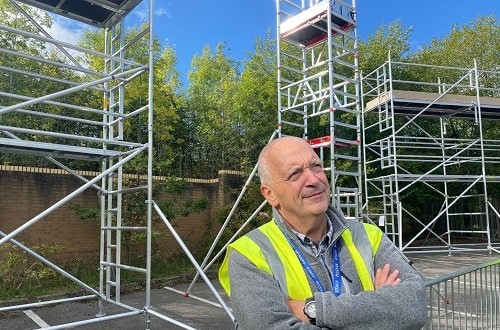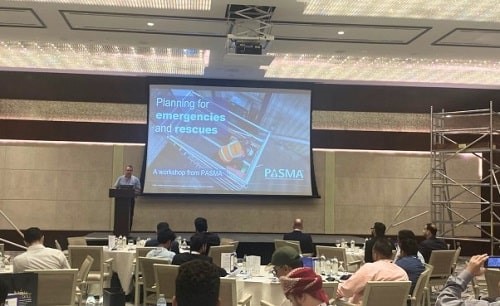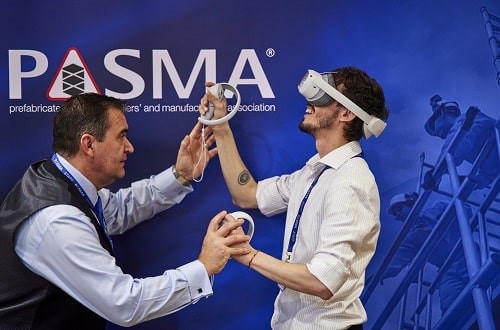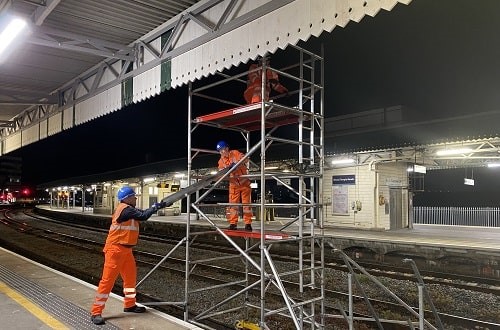Although big improvements have been made in ensuring the safe use of mobile access towers over the years, accidents still happen, so it’s essential users always follow some key precautions to prevent potentially serious falls and other dangers.
Features
Getting down to basics: 5 fundamentals of tower safety
This year marks a big milestone for PASMA as we celebrate 50 years of advancing tower safety. Founded in 1974, today the association has more than 360 members ranging from tower manufacturers and hire centres to training companies and hire and assembly businesses. Each of them works alongside PASMA to champion safe equipment, administer industry-standard training and share expert guidance.
During PASMA’s lifetime, the number of accidents on towers has reduced significantly. But, five decades on, falls do still happen and often it’s the same factors at play:
- Lack of planning
- Unsafe equipment
- Lack of training
- Incorrect assembly
- Improper use.
So, as we celebrate progress, it’s an opportune moment to revisit the basics of tower safety. Because while the future will bring further improvement and innovation, there will always be fundamental steps that must be taken each time you or your team works with a tower.
 Don Aers is technical director at PASMA. Photograph: PASMA
Don Aers is technical director at PASMA. Photograph: PASMA
1. Proper planning
Tower safety starts long before the operative picks up the first component. When work at height is unavoidable, everyone involved has certain roles and responsibilities that are determined in UK law.
As a manager, you must plan the work you going to do, set up a safe system of work, and supervise it properly. For example, your role includes:
- Selecting the most suitable access equipment for working at height
- Conducting a risk assessment
- Checking the weather forecast to be sure it’s safe to work with towers
- Making sure everyone involved, including yourself, is trained for the jobs they’ll be doing
- Ensuring the tower is inspected correctly by a competent person
- Planning for emergencies and rescues.
Serious injuries
Last year, a shopping trolley manufacturer in Coventry was fined £320,000 for failing to ensure that work at height was properly planned, appropriately supervised and carried out in a safe manner. This resulted in an employee being seriously injured after climbing an incorrectly assembled tower and falling through the roof of a metal cage. Working at height wasn’t part of his normal duties, but that didn’t matter. It must be done properly, even if it’s a one-off activity.
We recommend that managers and supervisors complete the PASMA Towers for Managers training course to help them understand their responsibilities and carry them out successfully.
2. Safe equipment
When you’ve decided to use a tower, choose a safe, reliable one. This isn’t the time to cut costs or pick the first item you find online. Only a good quality tower will provide your team with a safe working platform, so do your research.
Select the right tower
Towers come in different shapes and sizes and it’s important to choose the right one for each job, considering factors such as the ground space available, the platform size required and the height you need to reach. A simple mobile access tower might not suit: you might need a cantilever tower, bridged tower, linked tower, large deck tower or stairway tower instead. If you’re working near electricity, choose a GRP (fibreglass) tower over aluminium to reduce the risk of electrocution.
Check it’s certified
To be sure the tower includes all the safety features you need, check that it’s certified to the relevant design standard.
If it’s a mobile access tower – a straight up and down, single bay structure with four legs and wheels – it must comply with BS EN 1004. If it’s another configuration of tower, such as a cantilever tower, the relevant standard is BS 1139-6.
We’re often asked if there’s a law about only using towers that meet the standards, and the answer is no. However, there is a legal requirement for employers to provide safe equipment for working at height, and using towers that meet the appropriate standards is a recognised way of demonstrating that.
To save time, simply choose towers that are manufactured or supplied by PASMA members.
It’s a condition of membership that their towers meet the most up-to-date standards and are independently certified.
Inspect your equipment regularly
Tower components can become damaged or worn over time, so if you own towers it is essential to regularly inspect the equipment to ensure it remains in good working condition.
3. Training
Where to start
Even a certified tower is only safe if it’s assembled, inspected, used and dismantled by competent workers. Anyone working with a mobile access tower should have a current PASMA Towers for Users qualification. This can be done at a PASMA training centre or on your own site, and can even be part-completed as e-learning.
Extra training as needed
Additional training is needed for anything other than a simple BS EN 1004-1 mobile access tower. There’s a range of BS 1139-6 tower configurations available, with a corresponding PASMA training course for each of them:
- Cantilever towers
- Towers on stairways
- Towers with bridges
- Linked towers
- Large deck towers.
Outsourced assembly
If it’s not practical to have your own workers trained, or if you need a non-standard tower designed for your site, use a PASMA hire & assembly member. Their qualified access tower specialists will assemble and dismantle the tower for you.
PASMA is part of the Construction Skills Certification Scheme (CSCS) Partner Card Scheme, so access tower specialist cards feature the CSCS logo. This provides a familiar and reliable way for construction managers to verify qualifications and training.
4. Assembly and dismantling
Follow the instruction manual
Even though the person assembling the tower is trained, they must always have, and follow, the instruction manual provided by the manufacturer or hirer. It must be available on-site as it contains critical safety information, including:
- How to assemble the tower without ever standing on an unprotected platform
- The bracing pattern, which gives the tower its strength and must be followed exactly
- The maximum safe working load
- How to stabilise the tower to prevent it toppling over e.g. by using stabilisers, outriggers, ballast, or by tying it into an adjacent structure
- Information about hazards.
Following the manual is the only way to ensure the tower has all the strength, stability and safety features that its manufacturer intended. Instruction manuals are so important for tower safety that they even have their own standard, EN 1004-2.
If you need to alter or dismantle the tower, take the same amount of care as you did when assembling it. Don’t make any alterations that aren’t approved by the manufacturer, such as removing braces that are acting as guardrails.
Safe assembly methods
There are only two ways to assemble and dismantle a tower safely – the 3T, through the trap method, or by using an AGR (advance guardrail) tower. Using either means you never need to stand on an unprotected platform. That is, one without double guardrails all the way around all four sides of each platform.
Level your tower
Use a spirit level to check the tower is level as soon as the bottom end frames and braces are assembled and before it’s built any higher. If the tower is not level, it can be unstable and will overturn.
Inspect the tower before use
Don’t forget the tower needs to be inspected after assembly and before use, to ensure it has been assembled correctly. A report of the inspection (which can be in an electronic format) must be available on-site and kept for three months after.
5. Safe use of towers
Ascending and descending
Towers have a built-in stairway, stair ladder, inclined ladder, vertical ladder or climbing end frames so you can access the platforms safely. Here are some do’s and don’ts for climbing towers safely.
DO:
- Check the instruction manual to see what type of access your tower has and follow the method shown when climbing and descending
- Use the built-in means of access to climb the tower on the inside
- Use trapdoors to enter and exit the tower’s platforms
- Close all trapdoors as you go, so that if you were to fall, you’d only fall as far as the next platform. This safeguard only works if you always climb the inside of the tower.
DON’T
- Don’t climb the outside of a tower. There’s every chance that it will overturn, or you could lose your grip and fall
- Don’t use a tower in adverse weather
- Don’t lean portable ladders against the tower as a means of access. It’s dangerous and it’s unnecessary. Not only could the tower topple over, but if you lost your grip, there is nothing to break your fall.
Moving towers
Towers that have wheels can be moved around quickly and easily. Before moving a tower, check your route for obstructions, both on the ground and overhead. When you’re ready to go, reduce the height of the tower to a maximum of 4 metre platform height.
But, if there are fewer than four correctly positioned stabilisers on the tower, for example because it was previously in a corner, take the height down to 2 metres.
Keep the stabilisers in position, raised no more than 25 millimetres (that’s one inch) from the ground. Ensure there are enough people on hand to control the movement of the tower. Then use your hands to push – never pull – at or near the base of the tower. Once the tower is in its new position, re-engage the wheel brakes, lower the stabilisers and use a spirit level to check it’s upright.
You don’t need to inspect your tower each time you move it, unless something happened that could have affected its safety.
Never move a tower with people, materials or equipment on any of the platforms.
Over the years, PASMA has looked for new and novel ways to improve towers, and to make it easier for operatives and managers to work with them safely.
For example, it was PASMA that led the way on big tower innovations like advance guardrails (AGR) and we worked with manufacturers to increase the range of standard configuration towers available to buy and hire. We invested heavily in the Test & Research Centre, the UK’s first specialist test laboratory, certification body, research facility and training space for access equipment. And we’ve taken advantage of technology to create the new inspection system TowerSure and a virtual reality fall from height simulation.
So, while the way we deliver information may have evolved, the basics of tower safety have remained constant.
Try it: rescue plan workshop
How do you rescue someone who is unwell or injured at the top of a tower? Every scenario is different, so there’s no step-by-step guide. But under the Work at Height Regulations, you do need to plan for emergencies and rescues from towers.
 The rescue plan workshop launched at PASMA Symposium Dubai in October. Photograph: PASMA
The rescue plan workshop launched at PASMA Symposium Dubai in October. Photograph: PASMA
PASMA has launched an emergency and rescue planning workshop, designed to get the audience thinking about what they might do in various scenarios. It includes insights into the many variables and discusses strategies for dealing with work at height emergencies.
Could your safety leaders benefit from this workshop? Get in touch: pasma.co.uk/rescue
Safety alert: DIY towers
PASMA has commissioned research into the safety of so-called ‘DIY towers’, which are sold online by irresponsible manufacturers, importers and suppliers as a ‘no frills’ alternative to EN 1004-1 towers.
Testing is under way now at the Test & Research Centre, a specialist test laboratory for access equipment in Cambridgeshire, with initial findings highlighting that guardrails supplied with these products are often not strong enough to support a user falling against them.
To receive a copy of the report, register at: pasma.co.uk/diy-towers
Innovation: virtual reality falls
PASMA has developed a simulator that allows people to experience a fall from a tower in a virtual reality environment. Users climb to the top of a mobile access tower and can choose to do that with guardrails or without guardrails. If there are no guardrails, a simple misstep or overreach at the top will lead to a fall from height.
 PASMA has developed a simulator that allows people to experience a fall in virtual reality. Photograph: PASMA
PASMA has developed a simulator that allows people to experience a fall in virtual reality. Photograph: PASMA
The experience aims to supplement training by making people stop and think about the risks of working at height and how quickly life can change if you don’t take the right precautions to stay safe.
To hear when and where you can try PASMA’s virtual fall from height experience, sign up for our newsletter: pasma.co.uk/newsletter
Innovation: TowerSure by PASMA
TowerSure by PASMA is the smarter way to manage inspections for mobile access towers, tower scaffolds and podiums. Accessed via a mobile app and web portal, it reinforces training when it’s needed most, helps operatives build safe structures and provides personalised guidance for them – and their managers – on getting tower safety right. While in beta-mode, TowerSure is free for everyone. After that, it’ll still be free for small businesses or solo users, and affordable for all.
To try TowerSure and transform tower safety in your organisation, visit: pasma.co.uk/towersure
Free resource: tower safety videos
Using Towers Safely in Rail Environments is a series of 10 short videos for tower operatives in the rail sector.
They were created for the industry by PASMA, Taziker and Network Rail to improve safety for everyone who uses towers to work at height on the railway, although any sector will find them useful. The videos cover key areas of tower safety.
 The videos were filmed at Bristol Temple Meads railway station. Photograph: PASMA
The videos were filmed at Bristol Temple Meads railway station. Photograph: PASMA
All safety professionals are encouraged to watch, learn, share and – most importantly – use these videos freely to support tower safety in their own workplace and to remind operatives of their PASMA training right when they need it most.
Watch the videos on PASMA’s YouTube channel: youtube.com/pasmaltd
Don Aers is technical director at PASMA
FEATURES

Underpinning safety training with neuroscience for long lasting impact
By SSE Active Training Team (ATT) on 30 November 2025
A behavioural safety training programme developed by Active Training Team for energy provider SSE has been carefully designed with neuroscientific principles in mind – resulting in a prestigious industry award for Best Training Initiative in 2024.

Why a painted line will never be enough
By UK Material Handling Association (UKMHA) on 20 November 2025
Businesses that operate material handling equipment like forklifts are being urged to submit accident and near miss details to a new confidential reporting portal so the industry can identify what needs to be done to improve safety standards.

Why workplace transport training is changing in 2026 and what it means for employers
By AITT on 14 January 2026
New workplace transport training categories due in January mean it is essential to ensure operators of material handling equipment have the necessary training for the exact type of machine they use, and accredited training providers are an ideal source of advice and conversion training.



